 Expert's opinion
Expert's opinion
Expert's opinion
The article is a subjective view on this topic written by writers specializing in medical writing.
It may reflect on a personal journey surrounding struggles with an illness or medical condition, involve product comparisons, diet considerations, or other health-related opinions.
Although the view is entirely that of the writer, it is based on academic experiences and scientific research they have conducted; it is fact-checked by a team of degreed medical experts, and validated by sources attached to the article.
The numbers in parenthesis (1,2,3) will take you to clickable links to related scientific papers.
Jumping Rope To Lose Weight: 5 Exercises & Benefits In 2024

Some people have weight issues, with most focusing on losing belly fat. So, is skipping rope an excellent way to go about it? And what exactly is it?
Jump rope exercises are among the most common. That’s because, as children grow, jumping rope has been a game all along. Almost everyone has participated in an enjoyable jump rope game, including singalongs and choruses. As a result, it is initially thought to be a children’s game, but it may be more.
Jump rope for weight loss is also a plausible idea that you could give a try if you want to shed a few pounds!
Jumping up and down is good for burning calories and great for your muscles and heart. When you burn calories, you inevitably lose weight, so in retrospect, you are having fun, bettering your body, and losing weight: a win-win situation.
This piece covers all there is to know about weight loss and jumping ropes, so let’s begin.
Exercise For JumpRope Helps Lose Weight
- Basic jump
- Speed jump
- Heavy rope jump
- High knees and single-foot hop
- Double unders
Jumping Rope To Lose Weight: 5 Exercises To Try
To lower your body’s fat mass, you need to use the best exercises to get to your ideal weight. Please note that each jump rope exercise may require different ropes to achieve maximum agility.
So here are five jump rope routines that will get you there: pro or novice.
Basic Jumps
Basic jumps are the simplest form that entails skipping to your choice’s rhythm. Remember when you did it while growing up?
Those are simple and basic jumps that do not entail any modifications. With this simple routine, you will gain balance and coordination and build stamina as you go. The trick here is to maintain a constant speed so that your body adjusts to the movement before you advance.
For these jump reps, you require a simple skipping rope that is light and fits snugly in your hands. It would be best if you also used good shoes so as not to injure your ankles. In each session, strive to add five minutes to increase the calories burned.
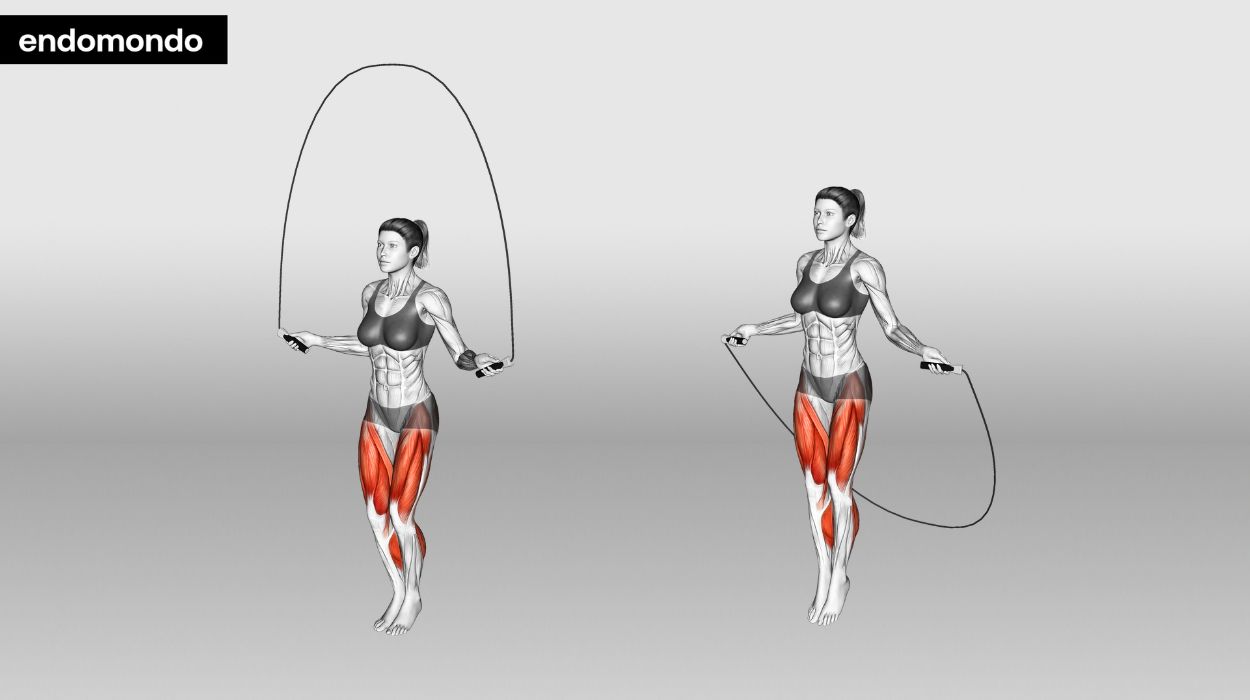
How to do:
- Stand with feet hip-width apart, holding jump rope handles.
- Swing rope over and under feet, starting with small jumps.
- Gradually increase jump height and pace.
- Maintain a steady rhythm while engaging the core.
- Jump for the desired duration, landing softly on the balls of the feet.
Tips:
- Start with proper rope length, allowing it to clear the ground.
- Land softly on the balls of your feet to minimize impact.
- Maintain a consistent pace and rhythm while jumping to maximize cardio benefits.
Optimal Sets and Reps: Three sets of two to three minutes of continuous jumping, with one to two minutes of rest in between.
Speed Jumps
Speed jumps are the next stage you will move to burn calories after gaining the essential coordination, balance, and timing from basic jumps. Speed jumping aims to increase the number of jumps per minute that you did in basic jumps.
The calves will be more engaged during these routine jumps since they endure extra pressure from the increased speed. Your reaction time will become faster, too, since you are jumping faster.
You will need a lighter skipping rope since the reps are faster and more intense. Always go for one that is adjustable with a good grip. With these jumps, aim to jump as many reps in a given time.
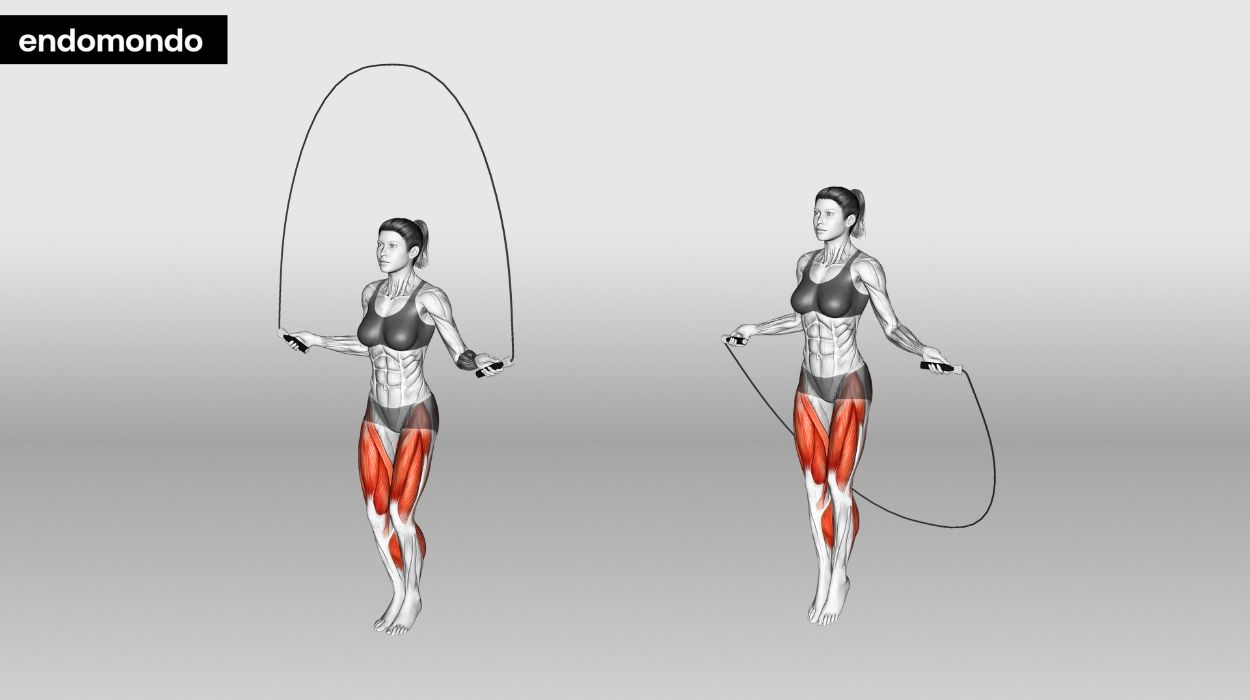
How to do:
- Hold the jump rope handles at your sides.
- Begin jumping, rotating the rope rapidly under your feet.
- Keep a brisk pace, jumping quickly and landing softly.
- Maintain core engagement and steady breathing.
- Perform for the desired duration, aiming for a continuous rhythm.
Tips:
- Start at a manageable pace to avoid tripping.
- Maintain proper form to minimize the risk of injury.
- Focus on quick, controlled jumps, prioritizing proper form for effectiveness and safety.
Optimal Sets and Reps: Three sets of one to two minutes of continuous speed jumping, with one to two minutes of rest in between.
Heavy Rope Jumps
As the name suggests, you will need a heavier rope that exerts more pressure on your arm, core, and shoulder muscles. Indeed, the speed you were going with the speed rope jumps will be reduced, but that is not a problem. Since you are working your upper body primarily, it is still beneficial.
These jumps work the biceps, triceps, shoulder, and core muscles while still engaging your body’s cardiovascular, pulmonary, bone, and muscle structures.
The increased intensity and resistance of the jumps push the body to produce more energy, thus, more fat burning and weight loss.
How to do:
- Hold a heavy rope with both hands at hip level.
- Swing the rope over your head and jump over it.
- Land softly, engaging core and calves.
- Repeat for desired reps, maintaining a controlled pace.
- Customize intensity and duration based on fitness level and goals.
Tips:
- Focus on consistent rope control and timing to maximize effectiveness.
- Start with a suitable rope weight to avoid overexertion.
- Maintain proper posture and form to prevent injury.
Optimal Sets and Reps: Aim for three sets of one to two minutes.
High Knees And Single-Foot Hops
For this routine, you may go back to using a lighter rope.
The high knee routine entails jumping while lifting your knees as high as possible. And single-foot hops are when you jump rope to lose weight with one foot at a time. Both of these exercises are particularly beneficial for increasing the intensity of the jumps. So much so that there is more fat-burning and energy expenditure.
You also increase the mobility of the knees and ankles and your overall balancing and coordination. You must keep shifting your center of gravity with either the high knee or single-foot hops.
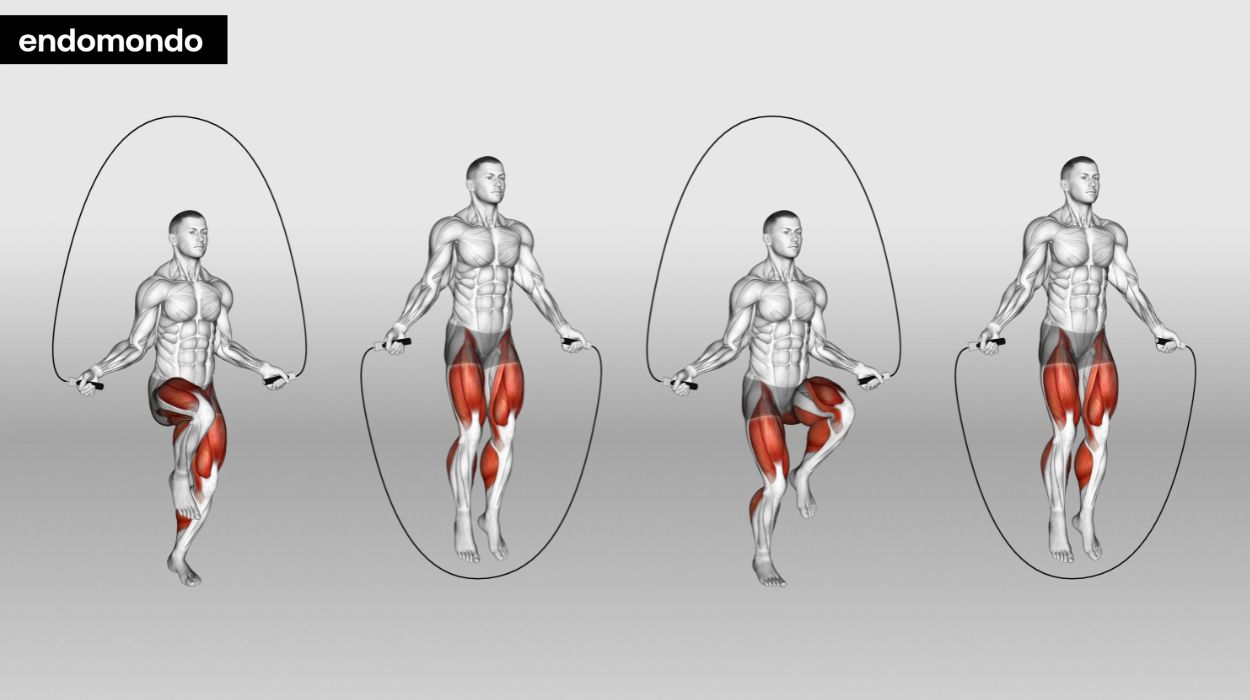
How to do:
- Begin with high knees, lifting one knee at a time.
- Transition to single-foot hops while maintaining a brisk pace.
- Alternate knees and hops for the desired duration.
- Engage the core and maintain steady breathing.
- Customize intensity based on fitness level and goals.
Tips:
- Start at a moderate pace to avoid straining or losing balance.
- Maintain proper form throughout, focusing on core engagement.
- Gradually increase the duration of each variation as your fitness improves.
Optimal Sets and Reps: Three sets of 30 seconds for each variation.
Double Unders
Double Unders are a more advanced jump routine that entails one passing two rope reps under one hop. These require more upper body stamina as you have to hold yourself airborne longer as you engage your upper body to move the rope faster.
For double unders, you need to use a lighter rope and even lighter shoes. You have to be super careful because the injury rate with these jumps is higher.
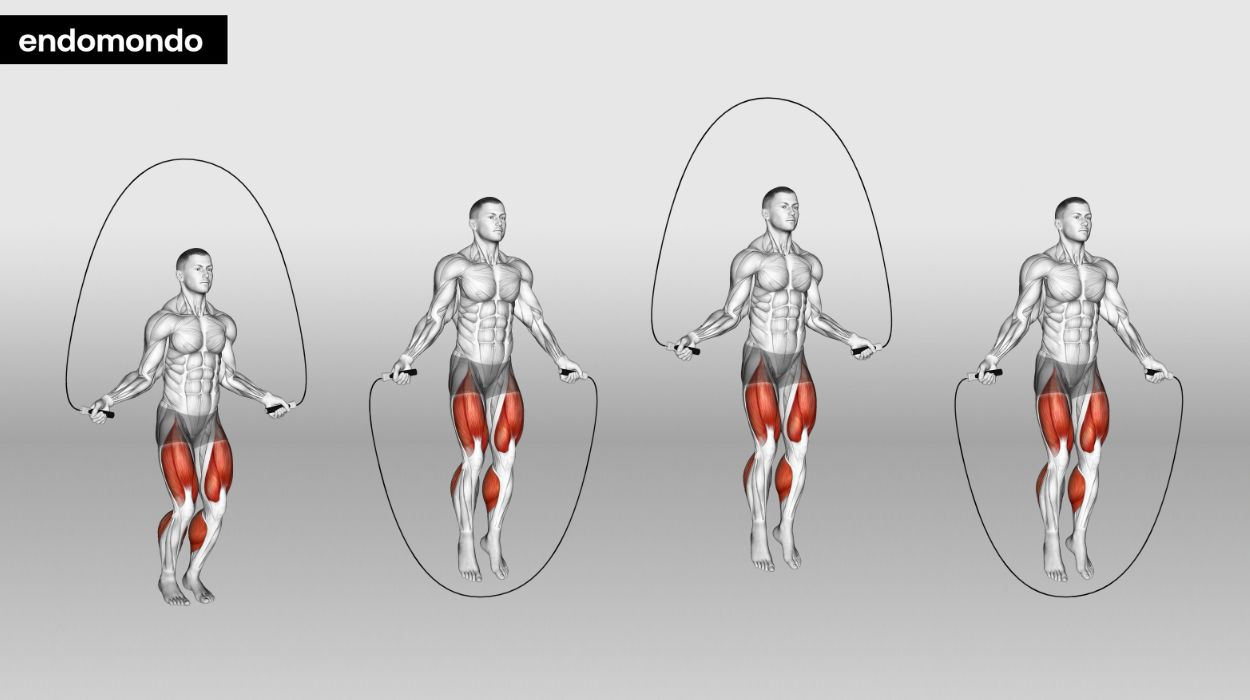
How to do:
- Hold jump rope handles at hip level.
- Jump, spinning the rope twice per jump.
- Use wrist flick for quick rotations.
- Land softly, keeping knees slightly bent.
- Practice for coordination and endurance.
Tips:
- Ensure proper rope length for your height.
- Maintain a relaxed grip to avoid fatigue.
- Start slowly and progress as you improve.
Optimal Sets and Reps: Three sets of 30 seconds. Adjust according to your fitness level and goals.
Is Jump Rope Good For Weight Loss?
Does jumping rope help you lose weight? Cardio is any exercise or physical activity that gets your heart rate up and stays there for a while. And as you work out, you breathe faster and deeper, enhancing your lung capacity.
These high-intensity workouts are beneficial because they get your blood pumping faster throughout your body. As a result, more oxygen and nutrients are supplied to all your muscles and body organs.
Jumping rope is one of the best exercises that boost cardiovascular and pulmonary fitness.[1] You breathe faster, and your heart rate goes up. So, yes, jumping rope is good cardio!
After some time of continuous jumping, more oxygenated blood must be carried to the engaged muscles, causing your pulse rate and breathing rate to increase to satisfy the higher demand for oxygen and nourishment.
This will help bolster your heart and continue to boost your lung capacity after a while, enabling you to work out for more extended periods. It results in faster detoxification, healing, respiratory health, cardiovascular fitness, and overall well-being.
Benefits Of Jumping Rope To Lose Weight
Besides the indisputable benefits for heart health[2] from a jump rope routine, here are the other jump rope benefits you get from it:
Burning Calories
Jumping rope is an effective full-body workout that is thermogenic, and that is how it helps you burn fat and support weight loss.
Muscle cells consume calories to allow the fibers to flex when you work out. The power from these calories is primarily used for motion, although a significant portion is wasted as heat. That is why you feel hot and sweaty while jumping rope. As you increase the intensity of your workout routine, more energy is dissipated in the form of heat.
In addition to burning more calories through jump rope, you’re also losing more calories due to heat loss. This boosts the fat-burning process and speeds up weight loss.
Muscle Strengthening
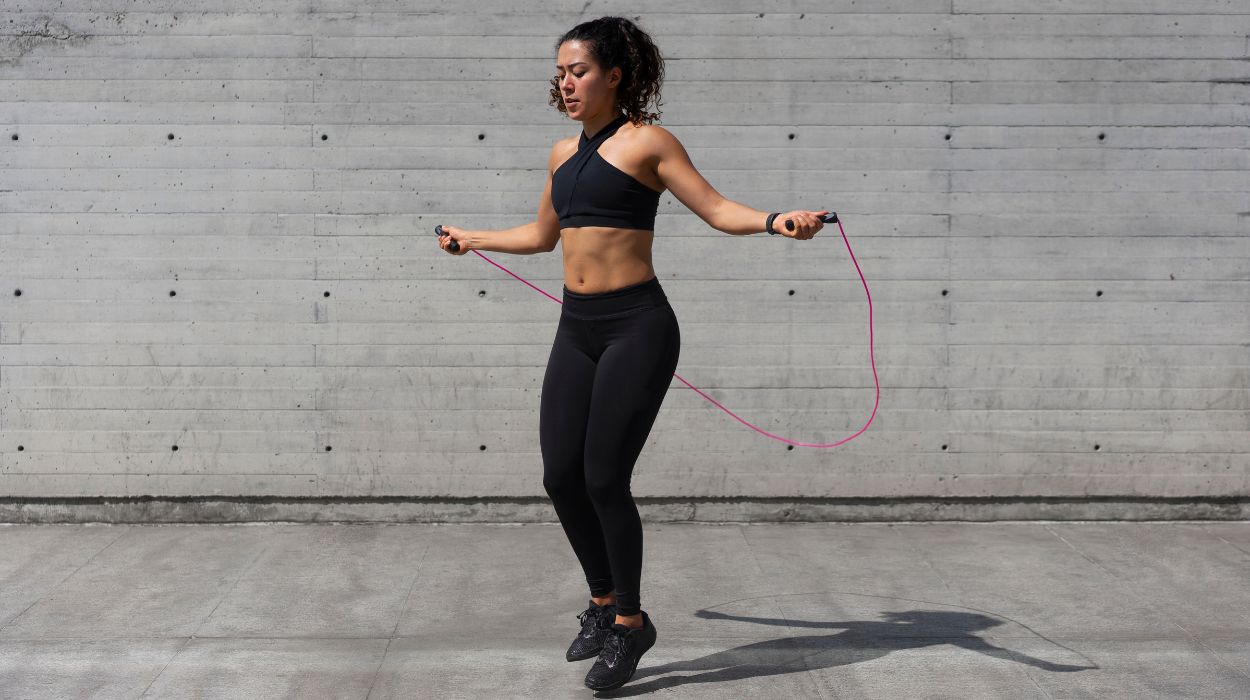
Jumping rope is a great way to get a full-body workout.[3] Jumping rope works your lower body, including the buttock, thigh, and calf muscles. In the upper body, it works the biceps, triceps, and shoulder muscles; in the midsection, it works the stomach muscles.
This can significantly help enhance muscle endurance muscular stamina and strength, which enables your muscles to work out for more extended periods. It also helps supply raw power, which is helpful in sports such as sprinting.[4]
It May Help Your Coordination And Balance
Including jump rope workouts in your training program will help you gain balance and coordination.[5] Jumping rope requires arm, leg, and torso synchronization and maintaining a consistent rhythm. Additionally, you must retain perfect balance to keep your center of gravity in your core and allow your feet to lift off the floor repeatedly.
You may choose how fast you jump and rotate the rope, so you can gradually improve your posture and balance depending on your demands.
Strengthening The Bones
Jumping rope is a high-intensity activity that strengthens the bones by putting them under a healthy amount of stress. The body reacts to the increased pressure on bones by reinforcing them to be sturdier and denser as an individual skips.
In one study,[6] after engaging in twenty minutes of skipping rope and full-body stimulation biweekly for 22 weeks, the bone mineral density of Olympic swimmers improved dramatically, mostly in the femoral neck[7] (part of the thigh bone) and the lumbar spine.
Because a rope workout is good for bone health,[8] it’s also an excellent strategy to avoid injuries. Moreover, jumping rope helps to increase ankle flexibility by training the muscles that support the joints.
Jumping rope and other comparable workouts have yielded similar benefits in other bones, like the hip bone in premenopausal women.[9]
It’s Entertaining
Exercising can be a chore for many individuals, but skipping rope may change that!
Jumping rope, especially done in a group with some music, is a fun and effective workout that can help you enjoy your workout again. With such a workout routine, you can change up your practice to add variety and difficulty.
The more you enjoy your workout, the more inclined you are to continue doing it in the long run.
How Many Calories Does Jumping Rope Burn?
The number of jump ropes calories burned will depend on the type of jumps you are partaking in and the duration of your skips. Your body weight is also another factor that may affect your calorie burn rate when you skip.
For instance, a 91-kg or 200-pound individual can burn 362 calories by jumping rope swiftly for twenty minutes. Or the same individual may burn 241 calories by jumping rope steadily for the same duration.
In a nutshell, including skipping rope into your everyday routine can assist in achieving the necessary calorie deficit for weight loss.
How Long Should I Jump Rope To Lose Weight?
You can burn between 15 and 20 calories every minute. So, according to simple math, a 15-minute jumping workout will burn 200 to 300 calories.
Regardless, you should conduct a thorough assessment before determining how long you should jump rope. Make healthier nutritional and other lifestyle choices to help this, such as minimizing alcohol and fast food consumption, which can slow you down.
Final Thought
As per the many studies on its efficiency, jumping rope is helpful for all age groups and genders: adolescents[10] and adults. It helps with heart health, bone, metabolism, coordination, and weight loss.
Jumping rope is beneficial, so it is wise to give it a try no matter what sport you are in, be it sprinting, boxing, soccer, or swimming. It helps you gain stamina and muscle endurance and increases bone density, balance, and coordination.
Your respiratory and heart fitness is also significantly impacted. And even if you are not a sporty person, jumping rope burn fat for weight loss is also helpful. You burn enough calories to lose weight from skipping just a few minutes.
+ 10 sources
Health Canal avoids using tertiary references. We have strict sourcing guidelines and rely on peer-reviewed studies, academic researches from medical associations and institutions. To ensure the accuracy of articles in Health Canal, you can read more about the editorial process here
- Seo, K. (2017). The effects of dance music jump rope exercise on pulmonary function and body mass index after music jump rope exercise in overweight adults in 20’s. [online] doi:https://doi.org/10.1589/jpts.29.1348.
- Research Quarterly. American Association for Health, Physical Education and Recreation. (2013). Comparison of Rope Skipping and Jogging as Methods of Improving Cardiovascular Efficiency of College Men. [online] Available at: https://www.tandfonline.com/doi/abs/10.1080/10671188.1968.10618043
- Moran, J., Ramirez-Campillo, R. and Urs Granacher (2018). Effects of Jumping Exercise on Muscular Power in Older Adults: A Meta-Analysis. [online] 48(12), pp.2843–2857. doi:https://doi.org/10.1007/s40279-018-1002-5.
- Kazuyoshi Miyaguchi, Shinichi Demura and Masashi Omoya (2015). Relationship Between Jump Rope Double Unders and Sprint Performance in Elementary Schoolchildren. [online] 29(11), pp.3229–33. doi:https://doi.org/10.1519/jsc.0000000000000543.
- Trecroci A;Cavaggioni L;Caccia R;Alberti G (2015). Jump Rope Training: Balance and Motor Coordination in Preadolescent Soccer Players. Journal of sports science & medicine, [online] 14(4). Available at: https://pubmed.ncbi.nlm.nih.gov/26664276/
- Montse Bellver, Franchek Drobnic, Jovell, E., Ventura Ferrer-Roca, Abalos, X., Luis Del Rio and Antoni Trilla (2021). Jumping rope and whole-body vibration program effects on bone values in Olympic artistic swimmers. [online] 39(5), pp.858–867. doi:https://doi.org/10.1007/s00774-021-01224-3.
- Zhao, R., Zhao, M. and Zhang, L. (2014). Efficiency of jumping exercise in improving bone mineral density among premenopausal women: a meta-analysis. [online] doi:https://doi.org/10.1007/s40279-014-0220-8.
- Ha, A.S. and Ng, J.-H. (2017). Rope skipping increases bone mineral density at calcanei of pubertal girls in Hong Kong: A quasi-experimental investigation. [online] 12(12), pp.e0189085–e0189085. doi:https://doi.org/10.1371/journal.pone.0189085.
- Zhao, R., Zhao, M. and Zhang, L. (2014). Efficiency of jumping exercise in improving bone mineral density among premenopausal women: a meta-analysis. [online] doi:https://doi.org/10.1007/s40279-014-0220-8.
- Trecroci A;Cavaggioni L;Caccia R;Alberti G (2015). Jump Rope Training: Balance and Motor Coordination in Preadolescent Soccer Players. Journal of sports science & medicine, [online] 14(4). Available at: https://pubmed.ncbi.nlm.nih.gov/26664276/



